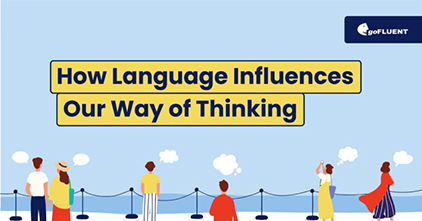One of the greatest abilities humans have is this — Language
For so long, people have treated words as mere labels for objects, and languages as different ways to string words together to convey thoughts, feelings and concepts. But language is more than that. Because of it, we can exchange complex thoughts and ideas to one another, whether it be spoken aloud or written in ink. It’s also through language that we’re able to trigger emotions, imagination and action.
Now of course, there’s no single language spoken around the world. There are more than 7,000 that exist today! And all these languages differ from one another in all kinds of ways; they all have different sounds, vocabularies and structures.
This, now, begs the question: Does language influence the way we think? Many have suggested that it does! It widens our perspective, deepens our knowledge, and changes the way we perceive the world. But in what way?
Language and culture go together
Language isn’t just a way to communicate, it’s a component of culture that makes it unique and specific. When language and culture are discussed, the phrase language is culture and culture is language is often mentioned because the two are always intertwined. This means that the language you speak reflects what your values and beliefs are.
According to anthropological linguist Daniel Everett, language can be considered a cultural tool to relate a community’s values and ideals, and is shaped and molded by these residents over time. For example, looking at the many idioms the Chinese culture has on family, you can definitely see how much they value that relationship.
More so, society and language are really mutually important to each other. Because every person’s linguistic ability, knowledge, and usage are somewhat influenced by the social context of how they were raised and taught. So, if you’re looking to learn a new language, prepare yourself to be introduced to a new world apart from your own!
Language changes how we see things
A great example is our different color perception. The number of terms we have for the colors we see varies from one language to another. For instance, English speakers name different shades of blue as dark blue and light blue. Russian speakers have two distinct categories for blue: it’s either “siniy” (dark blue) or “goluboy” (light blue). We do the same thing for another color: dark red and light red — the latter of which we call pink! With this, people who speak two or more languages are expected to focus differently regarding colors because different languages distinguish color in various ways. Amazing, right?
There are so many more examples of how language influences perception, like with regards to gender and describing events. But the bottomline is the same: languages don’t limit our ability to perceive the world or to think about the world, rather, they focus our attention, and thoughts on specific aspects of the world.
What this means for bilinguals
Given the things we’ve tackled, it’s no surprise that those who speak more than one language see the world differently. Numerous studies have shown that a new language can change how the human mind pulls information together, hence, enabling bilinguals (and even multilinguals) to have more than one perspective on a particular issue. Say, for decision makers, this may facilitate negotiations and the ability to see both sides of an argument and different points of view.
Even more benefits come from being bilingual such as improved performance, better memory, and increased confidence. Which is why multinational companies are looking to employ more bilinguals and also equip their workforce with global language skills they can use in the workplace and upon interacting with customers and clients such as those in healthcare and finance.
Is your organization doing the same? Because now that you know how powerful language is, you might want to re-evaluate your corporate training efforts.
Contact us to learn more about how to accelerate your company’s language learning.



